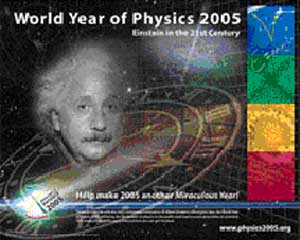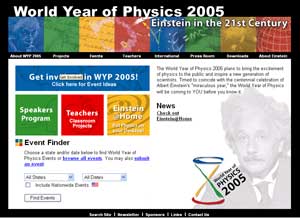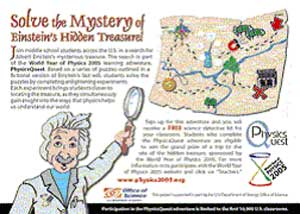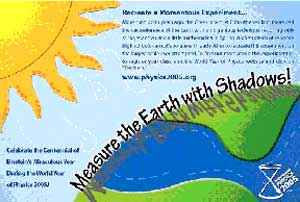Forum on
Education of The American Physical Society
Summer 2005 Newsletter
World Year of Physics 2005
Jessica Clark, American Physical SocietyHistoryThe celebration in 2005 of the World Year of Physics was proposed by the European Physical Society in 2000 to commemorate the 100th anniversary of 1905, Einstein's “miracle year” during which he published an incredible series of scientific papers, remarkable for their breadth and enduring consequences. He took the first step toward a theory of space and time, known as Special Relativity, built the foundation for the quantum theory of light with an analysis of the photoelectric effect, provided the definitive proof of the existence of atoms by his explanation of Brownian motion, and ended that remarkable year by identifying the equivalence of matter and energy, encapsulated in the world's most famous equation, E=mc2. The International Union of Pure and Applied Physics (IUPAP) passed a resolution during its 2002 General Assembly in Berlin, Germany, declaring 2005 the “World Year of Physics.” On June 10, 2004 the General Assembly of the United Nations declared 2005 the “International Year of Physics” and the 108th Congress of the United States passed resolutions declaring 2005 the World Year Of Physics. Purpose Physics organizations around the globe are planning a variety of programs in 2005 to raise public awareness of the contributions of the physics discipline and to promote the study of physics.In the United States, the phrase Einstein in the 21st Century” has been added to emphasize that his discoveries are relevant for science in this century. Key Collaborations in USWhile the APS serves as the lead organization for the World Year of Physics 2005 in the United States, the year would not be possible without the joint efforts of the entire physics community—AIP, AAPT, SPS, NASA, NIST, the National Science Foundation, the Department of Energy's Office of Science, and innumerable others. At the APS, the World Year of Physics Team consists of Jessica Clark, James Riordon, Vinaya Sathyasheelappa, Alan Chodos, Judy Franz, and inexhaustible interns. APS Projects National office-driven projects are PhysicsQuest for middle schools, Radius of the Earth/Eratosthenes for high schools, Physics on the Road for schools at all levels, and Einstein@Home for everyone. PhysicsQuest
Over 5,000 participating classrooms received a kit with experimental materials, including a diffraction grating and laser, an in-depth teacher's guide with treasure maps and activity handouts, and a 7-minute video featuring an actor playing Albert Einstein describing the wonders of solving puzzles and mysteries with physics. Using these materials the students determined the exact time of day and the position on the grounds of the Institute for Advanced Study in Princeton, NJ where a “treasure” will be delivered. A classroom was randomly selected from the submitted results to travel to the IAS and receive the prize. At the appointed time and place on May 21, nine students from the physical science class at St. Albert Catholic Schools in Council Bluffs, Iowa were presented with iPod Shuffles and a five-inch programmable telescope for their classroom.Incidentally, these students had chosen to participate in the PhysicsQuest as an extra-credit assignment. They worked on it before and after school for a week. Given the success of this project and the availability of resources, PhysicsQuest will run again in Fall 2005, and we hope to be able to continue with new PhysicsQuest projects each year.
Eratosthenes The Eratosthenes Project challenged high school students to measure the size of the Earth using shadows. Over 700 high school classrooms from across the US, Canada, and Mexico were paired together. Each pair measured the angle of the sun, in the same way that the Greek philosopher Eratosthenes did more than 2000 years ago in Alexandria, Egypt by comparing the length of an object to the length of its shadow, measured at local noon. The students calculated Earth's radius using the known north-south distance between the two schools and the angle of the sun at each location. Using the data submitted by participating classrooms, a grand average result was determined to be 6563 km, only 6% off from the accepted value of 6371 km not bad for a stick, a shadow, and a little mathematics! For participating, each teacher was sent a commemorative certificate and World Year of Physics lapel pins for their students.
Community-Driven Projects There are many other projects organized independently throughout the physics community. Virtually every physics-oriented organization within the AIP member societies have organized programs or raised awareness of the World Year of Physics celebration. For example, the Optical Society of America (OSA) displays an enormous banner with the World Year logo on the side of their building facing the main exit to one of the busiest subway stops in Washington, D.C. It is hard to imagine that anyone who uses that exit is unaware of the World Year of Physics. The events and programs organized by the physics community are numerous and varied. The APS-maintained website, http://www.physics2005.org, tracks these events using the Event Finder. There are also event ideas for those still wishing to organize something before the end of the year. The website serves as THE resource in the US for information on the World Year of Physics. The site is maintained by Vinaya Sathyasheelappa (vinaya@aps.org), the World Year of Physics 2005 Coordinator. Conclusion The World Year of Physics continues through the end of 2005. There is still time to organize an event in your community! Examples include open houses, teacher workshops, demonstration shows, hands-on programs, science cafes, service club presentations, newspaper articles, and celebrating September 27 (E = mc2 day). Be creative and remember that anything that celebrates physics celebrates the World Year. Be sure to "brand" your event with the World Year logo (freely available on physics2005.org) and register it with the Event Finder database. However you choose to celebrate, remember to have fun; this is our year. Enjoy! Dr. Jessica Clark has been trying to figure out how the world works since age five when she determined that, given the size of Earth and the number of children living on it, there could be no Santa Claus (much to the dismay of her 10-year-old brother). Since then, Jessica received her B.S., M.S., and Ph.D. in physics from the College of William and Mary in Virginia. Her research involved studying the internal workings of the proton, one of the basic building blocks of the atom. Jessica now works to bring the excitement of physics to the public as the American Physical Society's Public Outreach Coordinator and as the Editor of PhysicsCentral.com. With the World Year of Physics 2005 (a global celebration of Albert Einstein's annus mirabilis), Jessica works to bring an understanding of Einstein's importance in our everyday lives to the public. clark@aps.org |
||||||||||||






